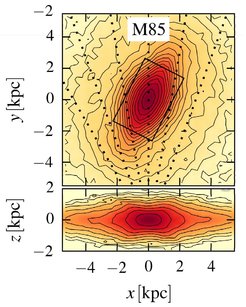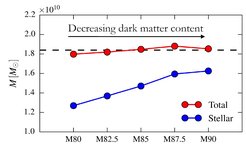Made-to-Measure models of the Galactic bulge
We construct dynamical models of the Milky Way’s box/peanut (B/P) bulge by enforcing N-body models of barred stellar disk to reproduce a set observables data using the Made-to-measure method and our NMAGIC code. The stellar particles are constraint to match the 3D density of RCGs measured from the VVV data together with stellar kinematics from the BRAVA survey. The stellar dynamics respond to the total gravitational potential, that includes the contribution of the dark matter in the bulge. We work on several N-body models with different dark matter fractions in the bulge and find from the modelling a very accurate measurement of the total mass (i.e. stellar + dark matter mass) of the Galactic bulge of 18.4 ± 0.7 billions of solar masses, with an unprecedented accuracy.
How much dark matter there is in the inner Milky-Way? Unfortunately, the kinematic signature of the ratio of stellar to dark matter mass in the bulge is not strong enough to appear in the data we used. However, using additional luminosity measurements from the COBE satellite we compute the stellar mass-to-light ratio of our models and find values in the K band in the range 0.8–1.1. These values can be compared to predictions of population synthesis models for an old stellar population originating from different Initial Mass Functions (IMF). We find that our mass-to-light ratios are inconsistent with predictions from the Salpeter IMF, ruling it our for the Galactic bulge. Prediction from the Zoccali IMF requires about 40% dark matter in the bulge.



